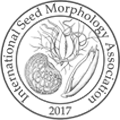Seed ID Forum › Seed ID Forum › Seed Morphology and Identification › Unknown seed
This topic contains 4 replies, has 2 voices, and was last updated by ID0000359d2659ea09344f3bbfd31920dd5f19911208650bb 1 year, 6 months ago.
-
AuthorPosts
-
September 27, 2022 at 2:21 am #621
Can you help identify these seeds? They were lodged behind a wooden beam in our house. They are shiny black, 3-sided and about 3mm long. When crushed with a hammer, the inside is red and white. Thanks for any insight!
Attachments:
You must be logged in to view attached files.September 28, 2022 at 2:32 pm #623Hello Margaret,
That is such an interesting place to find seeds, I wonder how they got there?
Your image is great, I can see the shape and size of the seeds well. I have a couple of questions for you:
– Where were these collected from? Exact location isn’t needed, just the region, province or state please.
– Are the sides of the seeds smooth and glossy, or are they roughened?Thank you, Jennifer
September 28, 2022 at 2:56 pm #624Hi Jennifer,
About 1/2 liter have fallen to the floor, so I’m assuming a critter has been hoarding them for some time, although we haven’t spotted anyone other than an occasional mouse.The house sits on the edge of a forest in the Green Mountains of southern Vermont, facing a rocky meadow–elevation of about 2500 ft. The sides of the seeds are smooth and glossy.
Thanks so much!
MargaretOctober 3, 2022 at 4:37 pm #625Hello,
Thank you for the detailed site location. I’m curious if there are many hardwoods in that area that display beautiful Fall colours?
The seeds in your photo are in the Polygonaceae family (includes buckwheat and dock), and are technically one-seeded fruits called achenes. The papery reddish layer you found is the seed coat, and the whitish part is the true seed. Just information for interest’s sake.
There are a few species with glossy, three-sided black achenes in your area; these ones most closely resemble Polygonum cilinode (fringed black bindweed) or P. scandens (climbing false buckwheat). I can’t tell from the images, but achenes of P. cilinode tend to have flat sides, and P. scandens have concave sides.
The achenes are nutritious, and some species of Polygonum have been collected for food by Indigenous peoples in the past. It seems like it was an animal of some type that brought the seeds into your house over a long period, a mouse or perhaps a meadow vole? Please let us know if you are able to solve this mystery.
I hope this helps, Jennifer
October 3, 2022 at 6:45 pm #626Hi Jennifer,
Yes, the forest is mostly birch, beech and maple trees and we are in peak leaf season–the landscape very beautiful now.
Thank you so much for the identification! The minute I saw images of P. scandens, I knew immediately it must be the source of the seeds! The vine has been overtaking the meadow and I could find some shriveled seeds still on the plants. I have heard mice in the walls at night, so I assume they are the ones who have been stockpiling the seeds over the years. So happy that the mystery is solved!
Thanks for your help,
MargaretAttachments:
You must be logged in to view attached files. -
AuthorPosts
You must be logged in to reply to this topic.



